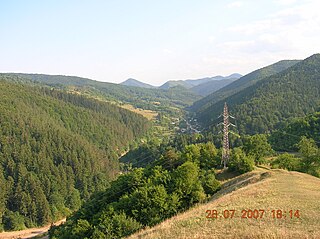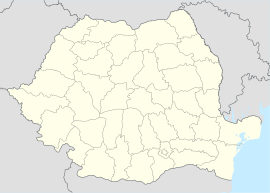
Neamț County is a county (județ) of Romania, in the historic region of Moldavia, with the county seat at Piatra Neamț. The county takes its name from the Neamț River.

Harghita County is a county in the center of Romania, in eastern Transylvania, with the county seat at Miercurea Ciuc.

Mureș County is a county (județ) of Romania, in the historical region of Transylvania, with the administrative centre in Târgu Mureș. The county was established in 1968, after the administrative reorganization that re-introduced the historical județ (county) system, still used today. This reform eliminated the previous Mureș-Magyar Autonomous Region, which had been created in 1952 within the People's Republic of Romania. Mureș County has a vibrant multicultural fabric that includes Hungarian-speaking Székelys and Transylvanian Saxons, with a rich heritage of fortified churches and towns.

Piatra Neamț is the capital city of Neamț County, in the historical region of Western Moldavia, in northeastern Romania. Because of its very privileged location in the Eastern Carpathian mountains, it is considered one of the most picturesque cities in Romania. The Nord-Est Regional Development Agency is located in Piatra Neamț.

Toplița is a municipality in Harghita County, Transylvania, Romania.

The Bistrița is a river in the Romanian regions of Maramureș, Bukovina and Moldavia. It is a right tributary of the river Siret. At Chetriș, near Bacău, it flows into the Siret. Its source is in the Rodna Mountains, at the foot of the Gârgalău Peak. It flows through the counties Bistrița-Năsăud, Suceava, Neamț, and Bacău. The towns Vatra Dornei, Bicaz, Piatra Neamț, Roznov, Buhuși, and Bacău lie along the Bistrița. The Bistrița is 283 km (176 mi) long, and its basin area is 7,039 km2 (2,718 sq mi).

Borsec is a town in Harghita County, Transylvania, Romania. The town and the surrounding areas are well known for their spas and mineral waters. It has a population of 2,585, with a majority of ethnic Hungarians.

Rodna Mountains are a subdivision of the Inner Eastern Carpathians in northern Romania. The name comes from the nearby Rodna Veche village. At 2,303 metres, Pietrosul Rodnei is the highest peak in all of the Eastern Carpathians.

Durău is a ski resort located in north-eastern Romania, in Neamț County, Moldavia near the Ceahlău Massif. The location is disadvantaged because of the lack of accessibility, the only access road being DN15 ; the regular route from Bicaz is closed as of February 2006 due to landslides.

Prundu Bârgăului is a commune in Bistrița-Năsăud County, Romania, in the historical region of Transylvania. It is composed of two villages, Prundu Bârgăului and Susenii Bârgăului (Felsőborgó).
Pintic may refer to several places in Romania:
The Bistricioara is a right tributary of the river Bistrița in Romania, which it joins at the upper end of Lake Izvorul Muntelui, near the village Bistricioara. It flows through the villages Bilbor, Capu Corbului, Corbu, Tulgheș, Bradu, Grințieș and Bistricioara. Upstream from its confluence with the Borcut, it is also called Răcila. Its length is 64 km (40 mi) and its basin size is 770 km2 (300 sq mi).
The Rezu Mare is a left tributary of the river Putna in Romania. It flows into the Putna near Tulgheș. Its length is 16 km (9.9 mi) and its basin size is 47 km2 (18 sq mi).
The Putna is a right tributary of the river Bistricioara in Romania. Upstream from its confluence with the Putna Întunecoasă in the village of Hagota, it is also called Putna Noroioasă. It discharges into the Bistricioara in Tulgheș. Its length is 23 km (14 mi) and its basin size is 175 km2 (68 sq mi).

Corbu is a commune in Harghita County, Transylvania, Romania. The commune is composed of two villages, Capu Corbului (Hollósarka) and Corbu.

Întregalde is a commune located in Alba County, Transylvania, Romania. It is composed of eleven villages: Dealu Geoagiului (Havasgyógy), Ghioncani, Iliești, Întregalde, Ivăniș, Mărinești, Modolești, Necrilești (Nekrilesti), Popești (Popesti), Sfârcea (Szfirecsea) and Tecșești (Teksesty).

Tiha Bârgăului is a commune in Bistrița-Năsăud County, Transylvania, Romania. It is composed of five villages: Ciosa (Csószahegy), Mureșenii Bârgăului (Marosborgó), Piatra Fântânele (Báránykő), Tiha Bârgăului, and Tureac (Turjágó).

Bicazu Ardelean is a commune in Neamț County, Romania. It is composed of three villages: Bicazu Ardelean, Telec (Gyergyózsedánpatak), and Ticoș (Tikos).

Grințieș is a commune in Neamț County, Western Moldavia, Romania. It is composed of three villages: Bradu, Grințieș, and Poiana.

The Tarcău Mountains are a mountain range, part of the Moldavian-Muntenian Carpathians of the Outer Eastern Carpathians.



























